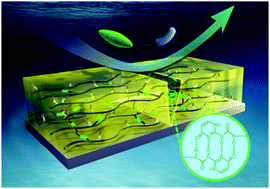Self-healing, highly elastic and amphiphilic silicone-based polyurethane for antifouling coatings†
Abstract
Silicone elastomer coatings have attracted increasing attention owing to their eco-friendly nature, excellent fouling release ability and drag-reducing property. However, the poor mechanical properties and lack of fouling resistance limit their applications. Herein, a silicone-based polyurethane with 2-ureido-4[1H]-pyrimidinone (UPy) and amphiphilic pendant chains is reported. The UPy groups and urethane can form hydrogen bonds with various substrates so that the coating has significantly improved adhesion strength (0.9–3.0 MPa) compared with the PDMS elastomer (0.3–0.4 MPa). Moreover, the quadruple hydrogen bonding between UPy moieties allows the polymer to have excellent self-healing ability and high elasticity. The modified polymeric coating has low surface energy (24 mJ m−2) and low elastic modulus (1.9 MPa), so it exhibits good fouling release performance. Besides, the amphiphilic side chains can effectively resist protein adsorption and adhesion of the marine bacteria Pseudomonas sp. and diatom Navicula incerta. The novel design can improve the resistance of silicone coating to biofouling and mechanical forces and is promising for high-performance antifouling coatings.



 Please wait while we load your content...
Please wait while we load your content...